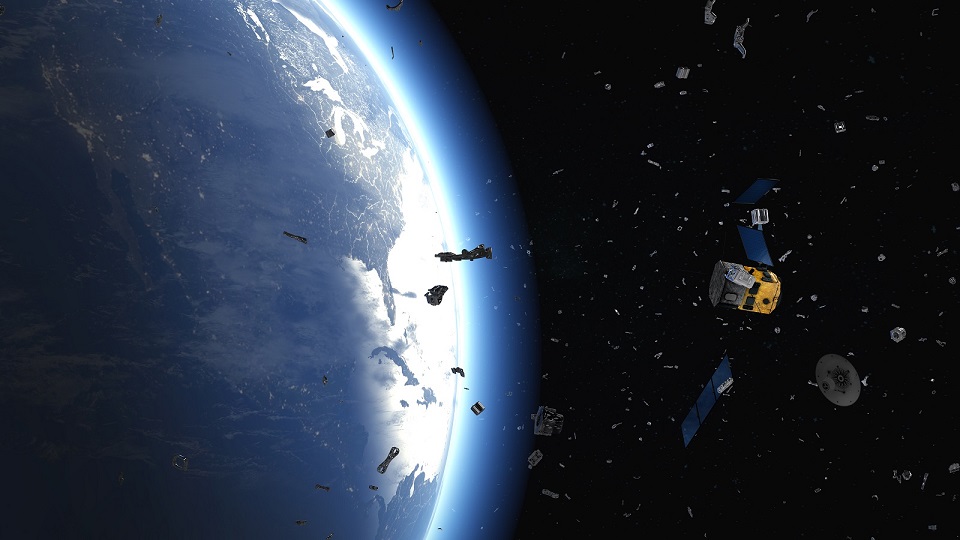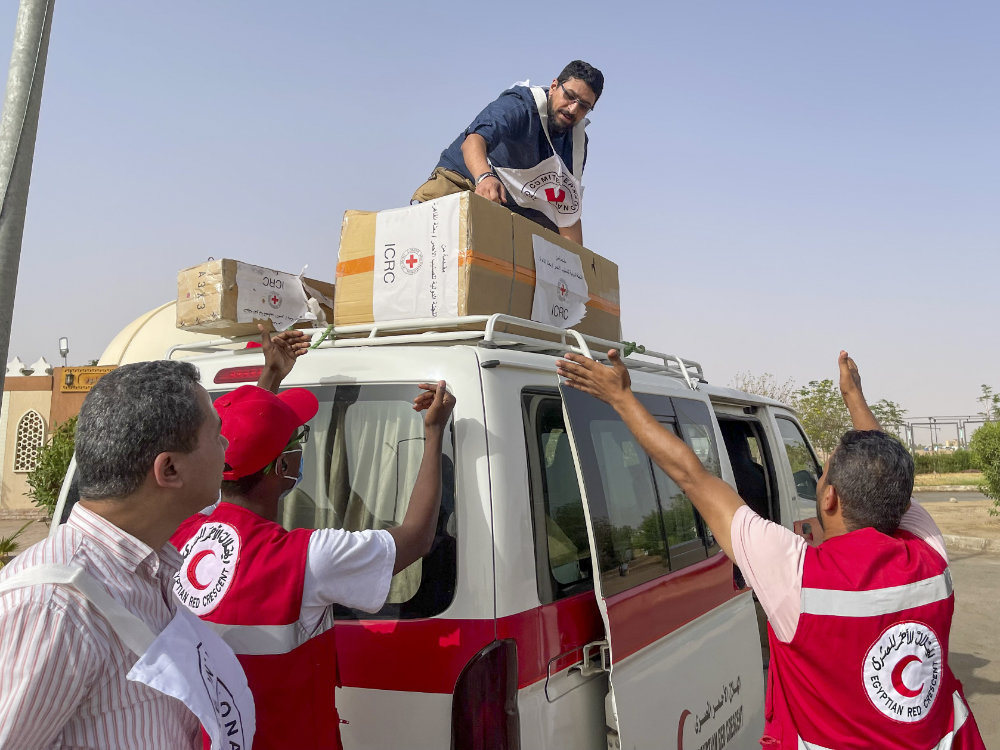Enabled by advanced technologies, the past few decades have seen a revolution in the utility and criticality of space systems for military operations as well as for essential civilian services and humanitarian relief operations. The military dependence on space systems has spurred the re-emergent competition of developing counterspace capabilities in major spacefaring nations. In parallel, military and commercial space systems have converged such that military operations make routine use of commercial systems and essential civilian services are now reliant on dual-use space systems. As the spectre of potential future armed conflict extending to outer space looms, essential civilian services including humanitarian relief are at risk of being disrupted or significantly degraded due to military operations against satellites and space infrastructure.
In this post, part of a series on War, Law and Outer Space, Gilles Doucet of Spectrum Space Security Inc., and Dr Stuart Eves of SJE Space Ltd, review the evolving and converging aspects of military and essential civilian space services, causes and results, highlight the risks to the civilian population should space systems be targeted and offer some policy options to mitigate civilian harm.
From the dawn of the space age, outer space has been used by the two cold war superpowers for military purposes. Beginning with surveillance, communications and navigation uses in the late 50s and early 60s, military space capabilities have undergone a major transition over the past few decades. The military use of space has evolved from mostly strategic applications, such as monitoring strategic capabilities, providing early warning, ensuring strategic command and control and verifying missile treaties. More recently, as evidenced by recent military operations from the Gulf War onwards, they also provide direct tactical support to military operations such as intelligence, surveillance, communications as well as targeting and guidance of weapons platforms.
Such a transition has motivated a resurgence of a competition of developing counterspace capabilities among major spacefaring nations. A range of military counterspace capabilities have been developed and/or are likely to be employed for hostile use, namely radio frequency interference with satellite communications, radio frequency interference with global navigation satellite services, cyber military operations, attacks on satellite ground stations, laser dazzling of electro-optical imaging satellites, co-orbital anti-satellite (ASAT) attacks, and direct ascent kinetic interceptor attacks, among others.
Increasing military use of commercial space services
Alongside this transition of military space capabilities, and driven by fundamentally the same technological innovations, there has been fast growth in the commercial satellite sector, with more applications and systems emerging. This trend has accelerated over the past several years with the deployments of large constellations of communications and remote-sensing satellites.
As commercial capabilities have grown in both sophistication and capacity, militaries have become important customers. The converse has also occurred with essential civilian services now reliant on space-based services, including military-owned and operated systems such as global navigation satellite systems (GNSS) and commercial space systems. As a result, many of today’s space systems are dual-use, i.e. they carry out simultaneously military and civilian functions. This commonality between the military and civilian interests in space is a source of potential humanitarian concern. The increasing reliance of military operations on both military and commercial space systems in current and future armed conflicts will certainly increase the risk of these systems being targeted, resulting in significant risk of harm on civilians and humanitarian actors relying on the services provided by these systems.
Essential civilian services increasingly reliant on space-based services
Essential civilian services include food, energy, water and sanitation, healthcare, communications, transportation, as well as finance, disaster and emergency prevention and mitigation and humanitarian relief. In most countries, these services are provided by sectors of national critical infrastructure, most of which are interdependent, which means the disruption of one can have reverberating effects on others. Two foundational sectors of national critical infrastructure are communications and energy, on which most of the other sectors rely – to a larger or lesser degree.
The level of reliance of essential civilian services on space-based infrastructure varies greatly from country to country and region to region. However, space services are increasingly being integrated into numerous aspects of civilian critical infrastructure worldwide; some countries are now classifying space systems as a distinct sector of national critical infrastructure, while in some other countries, space-based services are considered a critical element of other critical infrastructure sectors, such as communications, energy, financial, transportation, and emergency and humanitarian services.
In general, communications, navigations and remote-sensing space systems are the most important space systems necessary for the delivery of essential civilian services, since the two former capabilities underpin the majority of essential services, while the latter is critical for services such as humanitarian relief, disaster prevention and mitigation, and agriculture.
Satellites are critical to communications and energy/power sectors, because they supply the former directly, and are critical to the successful operation of the latter. National electricity grids often rely on precise timing from GNSS satellites for essential switching synchronization and management. Monitoring and control of valves within pipeline energy distribution networks also often rely on satellite communications systems. The global financial network is critically dependent on satellites to “time-stamp” international transactions.
Space systems also play an important role in providing warnings of significant humanitarian crises, including droughts, famines, and volcanic eruptions. They also provide vital data to be used in disaster prevention, prediction, preparedness and mitigation, in the event of catastrophes such as earthquakes, tsunamis and flooding events. Furthermore, humanitarian relief operations are increasingly reliant on these space-based services, especially in cases where the local civilian critical infrastructure is lacking, damaged or destroyed, including as a result of a natural hazard-induced disaster or armed conflict.
Potential human cost on civilians of military operations against space systems
The results of the above-illustrated evolution of both military and commercial space capabilities can be summarized as follows: on the one hand, essential civilian services have never been more reliant on space-enabled services, and on the other hand, the space systems providing those services have never been so threatened by potential counterspace operations against them, due to the military function of these often dual-use systems. This is certainly a very concerning trend.
If an unfortunate event of hostile military operation against a space system were to take place, civilians relying on space services would take a heavy toll. The exact humanitarian consequences of military operations against space systems vary case-by-case and are difficult to predict precisely, depending on the type of counterspace capability, the type of civilian service affected, the degree of reliance and the availability of alternate services. Some capabilities, such as radio frequency jamming and certain cyber operations, tend to lead to temporary effects on satellite services, while others, including direct ascent or on-orbital kinetic attacks, can damage or destroy satellites or ground stations, and most likely generate large amounts of space debris that may have lasting reverberating effects on space systems necessary for the functioning of critical infrastructure in many nations.
What is certain is that hostilities in outer space would have severe humanitarian consequences due to the high degree of reliance of essential civilian services on space systems and the drastic increase of dual-use commercial space systems.
The impact on civilian essential services is likely to be both immediate and long-term. First, there could be immediate interruption in space services such as communications, navigation and remote sensing. These would likely cause disruptions in essential civilian services such as energy, water and sanitation, transportation, food, healthcare, finance, disaster prevention and mitigation, emergency services and humanitarian relief. These interruptions could be local, regional or global, and of short or longer duration. The effects would depend on the nature of the hostile operation, the space systems targeted and the methods and means employed.
A secondary, long-term, impact could be damage to the space environment due to the creation of large amounts of space debris, in particular as a result of kinetic attacks against satellites, which risks damaging in an unpredictable manner other space objects in orbit. The severe long-term damage to the space environment would no doubt affect essential civilian services reliant on access to space-based services, as further discussed below.
How much space debris is too much?
The existing space debris population and its projected growth already pose a significant safety risk to all satellites in the Earth’s orbit. The debris population has steadily increased since the first satellite launches in the late 1950s. This is because it could take decades or centuries for the orbital region to clear debris under natural forces, depending on the orbit. The Vanguard-1 experimental satellite – the oldest space object still orbiting the Earth – which was launched in 1958 and became obsolete since 1964, has an estimated remaining orbital lifetime of 240 years.
Orbital space debris consists of several types of objects, including defunct satellites, rocket bodies, pieces released during normal operations, usually satellite deployment and rocket stage separation, and pieces from fragmentation events including collisions. The fragmentation events supply, by far, the largest amount of space debris. There are three major causes: kinetic ASAT tests, accidental collision of space objects and spontaneous explosions of satellites and rocket bodies. It is estimated that any kinetic ASAT attack in an armed conflict would likely generate thousands of additional pieces of debris. Therefore, the spectre of armed conflict extending into space with kinetic effects of generating space debris casts an alarming shadow on essential space-based services to the civilian population of all countries.
With the existing radar tracking capabilities, which are generally acknowledged to be able to track space objects larger than ten centimetres in size in LEO, approximately 45,000 space objects are being routinely tracked, with over 28,000 catalogued with known origin and approximately 17,000 analyst objects. Conjunction warnings of potential “near misses” are a daily occurrence for most LEO satellite operators. Even this number greatly understates the risk of causing damage to other space objects due to the estimated much larger number of debris pieces between one and ten centimetres in size, which are too small to be tracked and catalogued with current publicly acknowledged technology, but are still large enough to damage or even destroy satellites. National Aeronautics and Space Administration (NASA) and European Space Agency (ESA) debris models estimate that the number of debris pieces greater than one cm in size are approximately 500,000 and one million, respectively. Furthermore, estimates of debris pieces over one mm in size reaches more than 100 million, which may not be able to destroy an active satellite, but can certainly degrade its performance, for example by forcing it to move away from its assigned location to avoid a collision.
In light of the above, there is an ongoing debate concerning the level of debris density that would render Earth orbit – in particular LEO – “unusable”, but it is clear that kinetic military operations that are designed or expected to generate a large amount of space debris and indeed the tests of kinetic ASAT systems would significantly worsen the debris situation and bring the state of “unusability” much closer. Improving space surveillance capabilities – and mandating that all satellites should have propulsion systems to manoeuvre in order to avoid potential collisions with debris – would only alleviate this risk to some degree, but might only delay the inevitable.
What can be done?
Threats to satellites, ground stations and their data links due to the employment of military counterspace capabilities and potential counterspace operations place the civilian population in an increasingly precarious situation with regards to the assured availability of the essential services. It is therefore urgent for the international community as a whole to make every possible effort to prevent an armed conflict in space. It is also timely to consider a number of policy options, grounded in humanitarian concerns, that could mitigate the potential impact on civilians of disruptions to these essential services due to disruptive or destructive military space operations.
First, there is a need for states to recognize that outer space and certain space systems are indispensable to the survival of the civilian population and the delivery of essential civilian services, and to ensure their protection by: reaching a common understanding on those satellites that are indispensable to the survival of the civilian population and to the continuity of essential civilian services and functioning of persons and objects protected under international law, including in times of armed conflict; publicly identifying, announcing or otherwise indicating which space systems that provide critical space-based services to civilians; and ensuring protection of space systems that provide critical space-based services to civilians, such as the GNSS space segment.
Second, in order to protect the above-mentioned space systems, we need to: differentiate military from civilian space systems by improving and enhancing the registration of space objects for inclusion in the United Nations Register, in particular by providing timely and more detailed information of space systems that provide critical services to civilians; and, whenever feasible, physically or technically separate space systems and services (including satellites, communication links and ground stations, or parts thereof) that are used for military purposes from civilian ones.
Third, we must collectively mitigate space debris and protect the space environment by: prohibiting or imposing a moratorium on debris-causing ASAT tests, development and use; reducing the risk of armed conflict in space by working towards preventing the weaponization of space, including by agreeing on additional prohibitions or limits on certain military activities or weapons in outer space; and enhancing transparency and improving public sharing of space situational awareness information to limit the impact of debris on critical space-based services to civilians.
Lastly, there is a need to ensure the satellite services critical to humanitarian relief operations by publicly announcing or otherwise indicating which space systems humanitarian relief organizations are employing; advocating for the founding of an “International Space Charter for Humanitarian Relief” in times of armed conflict and other emergencies (analogous to the International Charter Space and Major Disasters); and providing humanitarian relief personnel uninterrupted multi-system access to satellite services to avoid the negative impact on humanitarian operations of disrupting services of a specific satellite system.
It is ultimately the responsibility and duty of states to adopt and implement national and international legal and policy frameworks that would reduce the risk of bringing armed conflict to outer space and, if the worst comes to pass, to mitigate the human cost of such a conflict. Additionally, international and civil society organizations and private entities, which have a stake in space safety, sustainability and preservation of essential civilian services, can play a role in advocating for states to adopt such human-centered measures. Last but not least, the space industry and commercial space operators that are in a position to do so are encouraged to contribute to the resilience-building of space-based services critical to civilians, by separating military from civilian services, where feasible, and by enabling humanitarian responders with uninterrupted access to space systems in emergencies. It is the common interest of all parties (states, non-governmental organizations, private entities and civil society) to ensure that critical civilian space services are maintained at all times and a concerted effort is required to implement protective measures while there is still time.
See also:
- Svenja Berrang, How would IHL apply to hostilities in outer space?, November 2, 2023
- Nivedita Raju, Space security governance: steps to limit the human costs of military operations in outer space, August 22, 2023
- Wen Zhou, War, law and outer space: pathways to reduce the human cost of military space operations, August 15, 2023







Comments